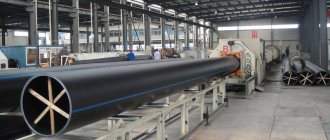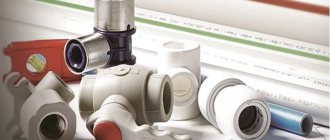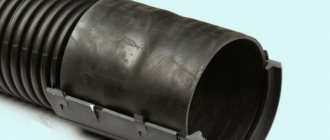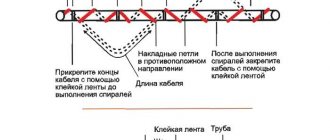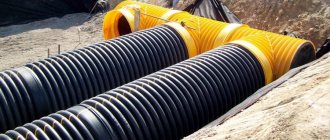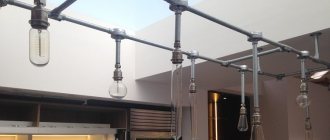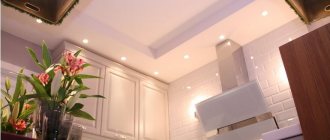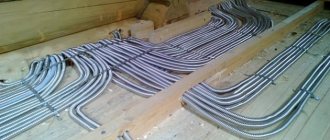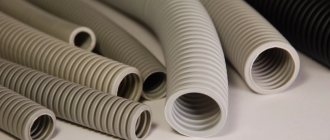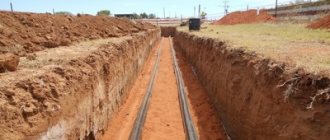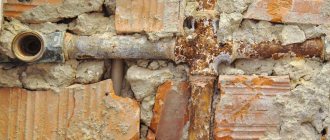In this article we will tell you about the use of corrugation, a popular material that has recently come into use in our everyday life, and we hope that this information will be useful to our reader.
Metal corrugation has widely entered our lives. Ventilation and air conditioning pipes, casings for wires and other pipes, hoses in a metal case (for example, a shower hose), pipelines in industry - flexible metal pipes with a ribbed surface can be found in every area of our lives.
What is corrugation and how does it work?
This is a corrugated flexible pipe (shell), structurally having a variable cross-section. It retains strength under numerous cycles of compression, tension and bending.
The starting material (sheet) is bent at a certain equal distance; the pipe manufacturing technology is a little more complicated. This processing of the source material helps to increase the strength of the material and increases the resistance to deformation during bending.
Types, materials and applications of metal corrugation
Types of corrugation according to design features:
- single-layer;
- two-layer: corrugated outside, flexible tube inside. Double-layer tubes can be divided into separate cells for several individual wires.
According to the design of the metal conduit for electrical wiring, it is divided into:
- thin-walled – light and flexible, designed for laying wires and cables;
- with reinforced wall - thick-walled, durable and heavier, designed for laying cables outdoors, in the ground, or poured into concrete.
Corrugated hose is used for:
- laying wires and cables in a protected sleeve;
- for laying protected water pipes - in plumbing equipment, for floor heating;
- ventilation pipes;
- Can be used for drainage - galvanized pipes with a diameter of 100 mm or more, a wall thickness of at least 3.5 mm and special perforation are used;
- There are also huge large-diameter steel pipes - they are mainly used for laying under roads to pass water, animals, pedestrians - they are very rare.
Where are metal corrugated pipes used?
The production of these products was initially mastered in Russia. This happened back in 1875 at a metal factory in St. Petersburg. Then, by 1896, their production was established in the USA. And only then did metal corrugated pipes appear in Japan, Korea and the African continent. In the USSR, serious attention was paid to their production. The older generation remembers the “construction projects of the century” - Transsib BAM and so on. The important role of metal corrugated culverts in this matter is undeniable.
In general, such products present on the modern market differ in diameter and cross-sectional shape. Actually, these parameters determine the scope of their application.
Important! When purchasing a corrugated metal pipe for electrical wiring, remember that the catalog usually indicates the outer diameter. It differs from the internal diameter by several millimeters.
Corrugated pipe products are produced with the following sections:
- round. This section is characteristic of a corrugated metal pipe used to create a culvert structure 1.5-7 meters high. The corrugated pipe for protecting wiring has the same cross-section, but only smaller;
- square. Corrugated pipes with this cross-section are used to create culvert structures and in the construction of tunnels (3-8 meters);
- pear-shaped. Tunnels, culverts (1.5-8 meters);
- arch. For small bridges, road and railway tunnels (height from 2 to 13 meters). Corrugations of this type can be installed in existing embankments by puncturing them;
- pipe-arch. Tunnels under roads and railways (height from 2 to 13 meters);
- vertical ellipse. This cross-section is suitable for telecommunications-type tunnels created on the basis of metal corrugated culverts;
- transition. Pedestrian crossings are built with their use (height 1.8-9 meters);
- horizontal ellipse. This cross-section is inherent in a metal corrugated culvert;
- arch with high or low profile. Small bridges, railway and road tunnels (height 6-15 meters).
Corrugated metal pipes come in different diameters and configurations
Application for laying cables and wires
In modern construction it is used everywhere to connect electrical equipment. When laying cables and wires open or hidden, installation in non-flammable pipes is required.
Straight pipes are inconvenient to lay, they do not bend, they need to be joined together, and the high flexibility of corrugated products is simply an ideal material for this task.
In rooms with aggressive environments, protection of cables and wires is also required. In practice, there are two options: plastic (most often PVC) and steel. Both materials have the ability to withstand fire for a long time, but plastic emits toxic gases when exposed to high temperatures, and therefore builders prefer steel.
Technical characteristics of steel hoses
Metal sleeves have many useful qualities:
- significant mechanical resistance, ability to resist deformation and rupture;
- flexible pipe facilitates installation; it can be laid in the most inconvenient places;
- light weight;
- environmental friendliness and safety for humans;
- durability - in a dry room and 50 years is not the limit;
- non-flammability;
- chemical resistance - especially important when used in industrial workshops;
- sufficient resistance to corrosion;
- protection of wires from moisture and water;
- protection against the movement of fire along wires in the event of a fire;
- UV protection and reducing the effect of overheating on wire insulation.
Types of corrugations for electrical cables
Corrugated hoses for electrical wiring are used when installing open wiring, when laying lines on the street or in a channel formed in a wooden wall. Corrugated pipes are produced from various plastics and metals. There are also composite options made of iron wrapped in a layer of PVC.
It is recommended to choose one sleeve for the street, another for installation in a screed or ground, and a third for installation behind interior cladding.
If the wiring is laid in a dusty room and the channel for it requires a sealed one, then it is best to take a plastic sleeve - the joints between it and distribution panels and boxes are much easier to seal
All corrugations based on strength, wall thickness and design are divided into:
- lightweight (withstand loads up to 320 N/5 cm2) – thin-walled, flexible and fragile, designed for installation under sheathing on ceilings and walls;
- medium (designed for loads up to 750 N/5 cm2) – recommended for installation in wall grooves;
- heavy (withstand up to 1250 N/5 cm2) – thick-walled and rigid, used when installing wires in screeds on the floor;
- super-heavy reinforced (designed for 4000 N/5 cm2 and above) - hoses made of twisted steel wire and plastic sheaths, needed for laying cables underground and on the streets by hanging.
The thinner the walls of the corrugation, the softer and more flexible it is. However, as the flexibility of a corrugated hose increases, its resistance to mechanical damage decreases. At the same time, it is difficult to bend a pipe that is too thick at a right angle; it may simply break.
But such heavy corrugated hoses provide more reliable protection from moisture and dust. This is especially true when laying cables in the ground.
Type #1 - metal hose
When compared to plastics, metal is obviously a more advantageous option in terms of strength. It perfectly protects the cable from chemicals, moisture, ultraviolet radiation, shock and compression. And in the event of a fire, a metal hose will last much longer than its plastic counterpart.
A corrugated metal hose is more fireproof and reliable than its plastic competitor, but it should not be laid in the ground - rust will inevitably do its dirty work
Metal corrugations for laying cables are divided into several types:
- RZ-Ts, RZ-TsKh, RZ-TsA – made of galvanized steel.
- RZ-SL and RZ-SL-X - made of tinned steel tape (tin plated with tin).
- RZ-TsP – with PVC insulation.
The letter “X” in the first two options indicates the presence of a cotton seal, and “A” an asbestos-cement seal. The "P" in the latter type of corrugation indicates the outer layer of PVC.
Also, metal hoses for wires exist with flanges at the ends and welded ends. Plus, there are variations of high pressure hoses in explosion-proof versions and for high pressure.
Image gallery
Photo from
Wooden floor with wiring in a metal hose
Wiring under a suspended ceiling
Metal corrugation with polymer coating
Entering a power line into a wooden house
However, such corrugated pipes are more intended for industrial conditions. They are not used for installing electrical wiring in the house due to their high price and fundamental uselessness.
Conventional metal hoses are made from steel tape by winding it in a spiral. At the same time, the resulting corrugation is not airtight. When pressed firmly, the joints of the tape immediately separate and the sleeve simply falls apart.
The metal hose is ideal for installing electrical wiring in a wooden house and outdoors; here its main advantage (non-flammability) comes in handy
If you need a sealed metal sleeve, you should take a product with additional insulation made of polyvinyl chloride. In this case, the top layer of self-extinguishing plastic will definitely prevent moisture and dust from reaching the steel base.
Only such corrugations are recommended for use in bathrooms and outbuildings, where constant changes in humidity and temperature are the norm.
Type #2 - polyvinyl chloride (PVC)
Gray electrical corrugations made of PVC are characterized by low price and self-extinguishing. In the event of a fire, they not only do not burn, but thanks to the additives in the plastic, they go out on their own.
The main disadvantage of any polyvinyl chloride products is their poor tolerance to UV rays. Under the influence of the sun, this material begins to simply “deteriorate,” which sharply reduces their actual service life.
Corrugated PVC pipes should be used exclusively indoors for wiring electrical wires using hidden technology, laying them behind cladding or other decor.
Another disadvantage of PVC corrugated sheets is their intolerance to low and too high temperatures, as well as excess humidity. When frozen, this plastic becomes brittle. In the cold it is destroyed even from a slight blow.
And in extreme heat (and even if in the sun), the corrugated polyvinyl chloride sleeve begins to soften slightly and “flow”. This does not lead to its immediate destruction or damage, but its service life is sharply reduced due to such operating conditions.
The situation is similar with water. With constant exposure to moisture, the walls of such corrugations begin to gradually collapse. These PVC pipes for water supply are initially designed for such an impact, but corrugated hoses have slightly different characteristics.
If the wiring needs to be laid in the bathroom or outdoors in direct sunlight, then it is better to look for another cable channel option for it.
Corrugated PVC pipes are ideal for installing wires in dry, heated rooms. They are cheap and flexible, and installation should not be difficult. But their gray appearance frankly does not please with its presentability and aesthetics.
Image gallery
Photo from
Wiring device behind a false wall
Laying wiring packages along the ceiling
Embedding of polymer corrugated hose
Gasket in brackets for suspended ceilings
It is best to cover such corrugations on top with finishing (wall panels, plaster with wallpaper on top or clapboard).
Type #3 - polyethylene and polypropylene
Corrugations made from HDPE polyethylene (or LDPE) and PPR polypropylene are approximately equal in cost and characteristics. They are resistant to strong moisture, temperature changes and ultraviolet rays. Such corrugated sleeves are universal.
They can be used both indoors and outdoors. For example, when installing a heating cable connection line, an electrical panel when entering a site, outdoor lighting branches, activating an irrigation system, etc.
In many properties, polypropylene and polyethylene are similar, their main difference is that PP cable sleeves are self-extinguishing, while PE sleeves are flammable
Both versions of these electrical corrugated hoses feel comfortable at air temperatures in the range of -40...+45 degrees Celsius. At the same time, HDPE is famous for its resistance to oils, acids and solvents.
It is recommended to use corrugated products made from it in garages, utility rooms and on the streets - that is, anywhere where aggressive technical liquids can get on the wires.
Advantages and disadvantages
In addition to the listed characteristics, the advantages include:
- affordable price;
- simple and easy installation;
- Fastening the casing is easier than fastening the wires - it sags less;
- convenient to store and transport;
- installation in a sleeve – additional protection against electric shock;
- ease of dismantling in case of repair and possibility of reuse when replacing wires.
Minuses:
- when placed outdoors or in damp areas, they are susceptible to corrosion, even many years after installation;
- electrical conductivity – if the integrity of cables and wires is damaged, this can pose a danger to humans.
Advantages and disadvantages of using metal corrugation
But it’s not only PUE standards that force the use of corrugation. This method of protection has a lot of additional advantages, and the higher cost of installing wiring in a metal corrugation is not a significant limiting factor.
Use of metal corrugation for industrial purposes
So the advantages of using corrugation include:
- Service life up to 50 years.
- It is easy to put on the wire with your own hands without the use of additional devices.
- Protection from mechanical damage and rodents.
- Not susceptible to atmospheric influences and aggressive environments.
- When grounding, which must be done in accordance with the PUE standards, provides additional protection against electric shock.
- Makes it possible to replace damaged cable sections.
- It is a completely non-flammable material.
- Metal is an environmentally friendly material.
- Has little weight.
But there are practically no disadvantages of using non-flammable corrugation for electrical wiring.
This may include:
- Higher cost of laying corrugated wire.
- Increased installation time for electrical wiring
- The possibility of formation and accumulation of moisture in the corrugation, which can lead to a decrease in the insulation resistance of the wire.
It is worth noting! That when using metal corrugation, PUE standards require that the possibility of moisture accumulation be excluded. To do this, the corrugation must be mounted so that moisture drainage is possible at the lowest point.
Where is metal corrugation used?
Wiring
The corrugation must be used:
- when laying wires and cables behind a suspended ceiling or false plasterboard wall;
- with open wiring;
- when laying the power supply network on a combustible base (wood);
- when laying wires and cables outside the building;
- when laying in basements and through the attic;
- when laying in a damp room.
When laying wires in grooves, installation in a cover is not necessary - modern double-insulated wire can be laid without a protective casing.
But we do not recommend using construction “noodles” with one layer of insulation in this case.
Warm floor
Installation of heating pipes in the floor without protection by reinforced corrugated pipes is strictly contraindicated! Flexible plastic heating pipes have little mechanical strength and are very sensitive to mechanical damage; they must be protected.
It is not necessary to protect the wires for installing heated floors with a durable cover - they are designed to withstand loads and to be filled with mortar without a cover. There is no risk of damage to the wire when walking or installing upholstered furniture.
Where else
Of course, one cannot help but recall all kinds of hoses with fittings for connecting plumbing fixtures and gas stoves, water heaters and heating boilers. Pipes of ventilation systems are often also mounted from steel corrugation with a diameter of 100-150 mm.
Corrugation cannot be used for the installation of chimneys - it is prohibited by regulations, since its walls are too thin.
Purpose of metal corrugation
The product functions as a cover that prevents contact of wires with surrounding surfaces, mechanical damage to the cable, and protects against the ingress of water and exposure to ultraviolet radiation.
In addition to protecting wires, corrugation, from a fire safety point of view, protects surfaces, especially flammable ones, from contact with a heated cable and prevents fire, acting as a dielectric that protects against sparks hitting flammable material.
In the event of a short circuit, the corrugation prevents the spread of flame and also protects personnel from electrical injuries.
Metal corrugation is a product in the form of a hollow tube with folds and stiffening ribs parallel to its cross-section. This feature provides the corrugation with the main advantages - flexibility and high resistance to loads.
The strength of a corrugated pipe is explained by a simple physical law: the larger the surface area of the pipe material, the lower the total pressure on its walls. Therefore, the corrugated pipe is highly resistant to pressure and can easily withstand dynamic and static loads. This allows it to be laid above ground and underground, through walls, where it can withstand the pressure of soil and concrete.
The flexibility of corrugated pipe is another advantage due to which the product does not require additional transition elements, as is the case with conventional metal pipes. With its help, you can lay cables and make turns along walls, and avoid obstacles.
Important! In addition to metal corrugated pipes, there are analogues on the market based on polymers - PVC, polyethylene and polypropylene. The principle of operation and scope of application of such pipes is similar, but they are inferior in strength to metal shaped products.
Scope of application
The scope of application of metal corrugated pipes is wide: they are used in almost all areas of industry and in everyday life where it is necessary to lay a cable.
We recommend that you read: Crab fastening - connection system for profile pipes
Here are just a few examples of product use:
- electrical installation work in the house - laying wiring through walls, above suspended ceilings, under floor coverings, as well as in an open way;
- installation and connection of lighting devices and household appliances;
- installation of high-power electrical equipment in production;
- creation of extensive computer networks with connection to server rooms;
- powering a private home from an external source.
Sizes and prices
Metal corrugated pipe for electrical wiring is available with outer diameters of 16, 20, 25, 50 and 63 mm. The internal diameter is indicated as a fraction. The inner diameter should be significantly larger than the diameter of the wire or cable - this makes it easier to tighten them. Typically, a pipe with a diameter of 20 mm is used to distribute the electrical network throughout the apartment; for the supply from the meter, a pipe with a diameter of 25 mm is sufficient (for several wires or a power cable - 50 mm).
The price depends on the region, manufacturer and material: stainless steel pipes are expensive, galvanized iron pipes are more affordable. Double-layer pipes used for heating or pipes with fittings for plumbing and gas appliances are also more expensive.
You should not save when purchasing - a pipe that is too cheap most likely has thin walls, insufficient strength and will quickly begin to rust. The average price on the market is from 20 to 150 rubles per meter, depending on the type.
Characteristics of metal corrugated pipes
Replacing wiring in a panel house with your own hands
Metal pipes for electrical wiring differ in their characteristics, they should also be taken into account when purchasing a product.
Among other things, corrugated pipes for laying cables may differ in their performance characteristics
Based on their resistance to external loads, electrical wiring pipes are divided into the following types:
- very high (withstands loads up to 4000 N/sq.cm);
- high (withstands loads up to 1250 N/sq.cm);
- medium (withstands loads up to 750 N/sq. cm);
- lightweight (withstands loads up to 320 N/sq.cm);
- very light (withstands loads up to 125 N/sq.cm).
In terms of impact strength, metal corrugation can vary from 0.5 kg/100 mm to 6.8 kg/100 mm.
The nominal temperature of the metal hose can vary from -45C-+5C to +60C-400C.
Another important indicator when choosing the products described is the flexibility factor. Corrugation can be:
- hard;
- flexible;
- very flexible;
- flexible with memory effect.
The choice of characteristics of a metal hose for laying cables should be made taking into account the purposes for which the corrugation will be used in the future.
Installation
Using corrugation for home repair work is quite accessible even for a novice craftsman. The main requirements for work are thoroughness and accuracy. Quite accessible for women.
But regarding the installation of the power supply system itself, installation features, and materials used, you should consult with an experienced electrician before starting work. Electric shock is no joke!
Do not forget about safety precautions: when drilling holes in the walls, you will need glasses to protect your eyes; Must have reliable non-slip shoes.
What tools are needed
You will need the following tools and materials:
- electric drill/screwdriver with appropriate drills and bits - it’s better to have two in one, otherwise you’ll have to climb up the stepladder again;
- stepladders, scaffolding;
- dowels - the most popular - 4.5x40 mm. For weak plaster (lime plaster in old houses), it is better to take a longer one;
- special clips of the required diameter;
- the corrugated hose itself, preferably with a probe for pulling the wire; the price of a product with a probe is not much more, but the work is much faster and more convenient;
- mounting boxes with holes corresponding to the diameter of the corrugation;
- if pipes are laid inside the box, clamps are used;
- for laying in grooves you will need a groove cutter, alabaster (plaster), and a spatula;
- wire cutters;
- Bulgarian.
How to attach
Before installing the corrugation, a wire is pulled into it using a special probe (wire).
Holes are drilled in the walls for the dowels, the clips (or steel clamps in the channels) are mounted using the dowels, and they are snapped into the pipe clips. Clips are installed every 500 mm on a flat surface, in corners - at a distance of 100 mm from the corner. The ends of the pipes are inserted into the installation and distribution boxes through special holes. It is better to cut pipes with a grinder.
In fines (this type of work is rarely used, because electrical wiring can be installed in the walls without a corrugated hose), a pipe is laid, sealed with gypsum mortar, then the entire fine is sealed. The walls and ceiling are trimmed using a fence cutter. Boxes are also smeared into the wall.
When laying wires inside GVL or gypsum board walls, flexible pipes are laid on metal fasteners. On the ceiling, it is recommended to suspend the pipe from supporting structures using clamps.
Features of open installation on the street: for outdoor work, the corrugation is laid in clamps. Products with a reinforced wall are used - light corrugations are not used.
The MGTs are connected to each other using distribution/junction boxes or special couplings.
Features of installation and operation
Laying a cable in a metal corrugation is not very difficult, provided that the installation specialist has experience and sufficient qualifications. So, if you do not have the necessary knowledge to complete the work, it is better to use the help of electricians.
Installation of electrical wiring in corrugation can be done on any surface
Concealed electrical wiring is traditionally installed in apartments and residential buildings. In this case, the corrugation with cables is placed in grooves previously prepared for this purpose, which are sealed and plastered after installation. As an alternative, external electrical wiring can be used, which is usually hidden under suspended ceilings or under drywall.
If the installation of electrical wiring is planned in a cement screed of the floor base, the product for laying the cable should be of a heavy type - it is designed for a fairly high mechanical load.
When it comes to laying central lines, the cable is pulled into the corrugation before laying it. If we are talking about branches for switches or sockets, it is quite acceptable to carry out the wiring later.
When fastening external wiring, special clips are used. Their size is selected in strict accordance with the diameter of the corrugation itself. In the groove it is permissible to mount it on alabaster and other quick-hardening solutions.
